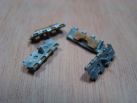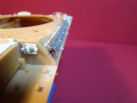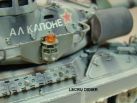Ref : Heller #81137
model and text by Didier Lecru

model and text by Didier Lecru

For many years, I was eager to build this model. In fact, I noticed a photograph showing a group of triumphant French legionnaires on an AMX30 displaying an odd or unusual camouflage. Lacking documentation, the project was asleep.
More than a year ago, the famous documentation arrived thanks to Mr. Lionel Gonnet. I would strongly commend him for his support without which the achievement would have been risky or dangerous. I also want to thank respectively Zurich, Olivier Carneau and the creator of Phebus Creations .
1 - SUBJECT
With the documentation now available, I decided to build an kit AMX30 FORAD fitted with the bracket for the mine-rollers and the fire simulator DX 175. For the general set-up, I went on the idea of a vehicle driving back from training session on a dirty chalky ground on a rainy day. Recently, beautiful photographs of AMX FORAD appeared fitted with a khaki "V" painted on the glacis. Nevertheless, I opted for an earlier version.
2 - BUILDING
This is the Heller kit that I think it is not long enough or wide enough. Only the thermal camera and two boxes of 20 mm ammunition come from the Phebus kit. The Azimut photoetched sheet has also been used. The bracket for the mine-rollers has been completely copied from the Phebus kit.
A - Hull
The engine deck has been completely redone to conform to the AMX30 B2 type. For that, I also used the Azimut PE grill. The exhausts have been shortened by more than a millimeter to set a part next to the exhaust manifold. Two fake fuel drums of dimension smaller than 200 liter drums were installed. The pioneer tools rack is redone as well as the oil filler caps, the fire extinguishers and the front side bins. The headlights are detailed. The spare trackpads were modified. Two crowbars are added. The driver's hatch is completed by affixing three vision blocks. The exhaust pipe of the crew heater was rebuilt more realistically. Screw knobs were added to the fuel caps and the battery air vents. The tracks were given a weathering similar to the model one. Before painting them, I brushed them with some acetone so that the paint sticks better.
B – Mine roller bracket
Having a Phebus kit, I copied it and improved the mechanism of attachment of the two cables connecting the rollers. The assembly includes at least 250 pieces of styrene.
C - Turret
It was amended by adding three different types of antennas. The DREB (smoke dischargers) are changed. The straps are shown rolled. The ammunition case disposal hatch was drilled out to set up the connection plate for the simulator. The DX 175 is made from scratch with the help of Zurich. Concerning the thermal camera, it is encased in a tube made with a syringe. The TC cupola was also amended by adding the wiper and its motor. On the barrel, a fake evacuator was added. The vision blocks are affixed to the front of the turret. On the bustle, a false snorkel and a container of two boxes of 20 mm ammunition from the kit Phebus are fitted.
3 - PAINTING
A primer coat of Humbrol #1 is overlain by gray #87. With difficulty, several stripes of black #33 are applied. Only the following parts are painted black, namely the undercarriage, the false evacuator, the thermal camera and the snorkel.
I opted for a vehicle leaving a training ground quite dirty. To represent the mud, I made a mixture of putty, very fine sand and acetone. The mixture is applied in particular on the lower part of the vehicle. The latter is painted with a mixture of #121 and #130. The model received a first coat of matt varnish. Then, several white filters cover the vehicle. These filters are accented on the parties likely to be the dirtiest. A second layer of matt varnish is applied.
White soft pastel is affixed to the passages used by the crew. Then, this pastel mixed with white spirit is added to the muddy parts. The grain is finer. After a last coat of matt varnish, the engine gets a white dry-brush. The DX was painted Humbrol #98. The flashing light is a piece of clear plastic sprue with a hole in the center to simulate a bulb . This piece has been coated with some Tamiya X24 transparent orange.
The exhaust pipes are painted light gray with some red brick in the center.
4 - MARKINGS
Repeatedly sought, Olivier Carneau told me that the FORAD camouflage enjoyed a certain freedom. As an enemy formation designed to represent the former Soviet empire, I decided to affix a red star and the name "AL CAPONE" but in Cyrillic. I was told that my design was possible. Thus, the red star comes from the Dragon Scud kit. I should have cut the edges to the transparent white border. As for markings, these are old dry transfers. Finally, red identification panels supporting numbers were added.
CONCLUSION
It has been a very interesting model to make because of its originality.

|

|

|

|

|

|

|

|

|

|

|

|

|

|

|

|

|

|

|

|

|

|

|

|

|

|

|

|

|

|

|

|

|

|

|

|

|

|

|

|

|

|

|

|

|

|

|

|

|
|